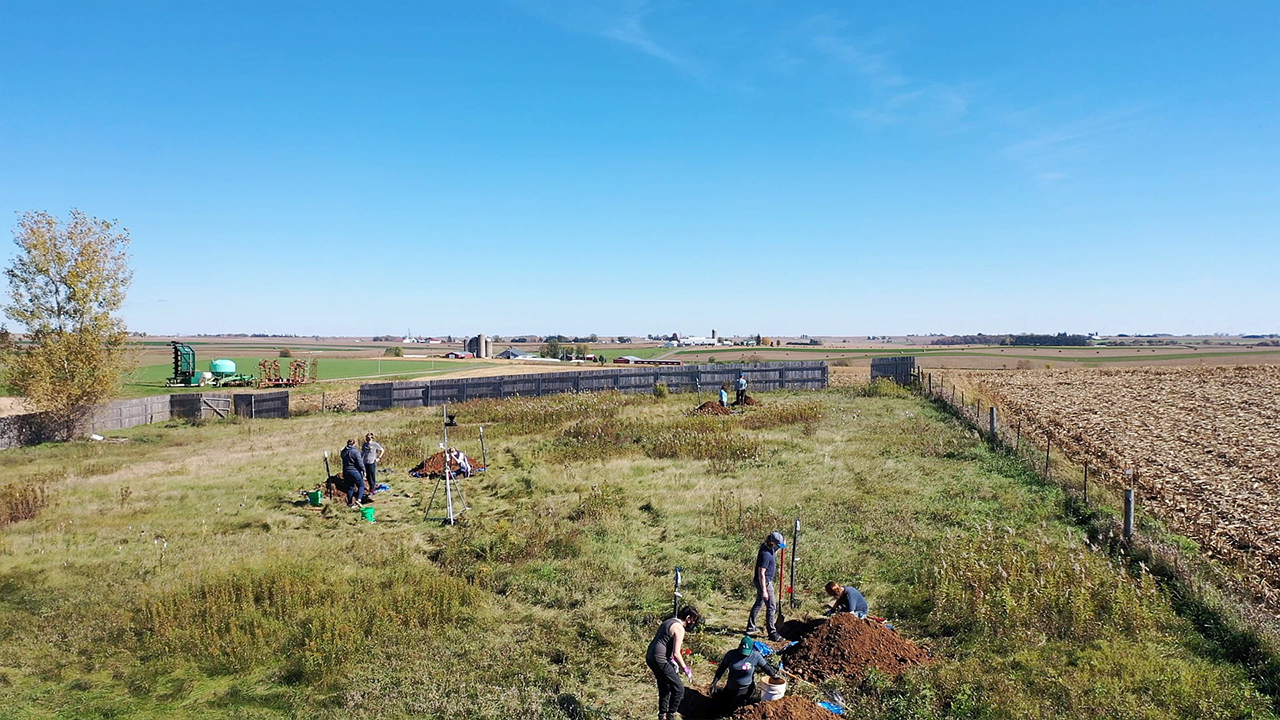
Dr. Sara Getz, assistant professor of forensic investigation and Dr. Patrick Byrnes, assistant professor of computer science and software engineering at the University of Wisconsin-Platteville, are collaborating on a research project titled, Clandestine Grave Documentation. Getz and her team of students are tracking local temperature, humidity, rainfall, soil moisture and temperature in undisturbed ground and monitoring mock clandestine graves with control graves at level depths of 18, 27 and 36 inches below the surface. Byrnes and his undergraduate researchers are taking a technological approach by using drone video to develop an algorithm to identify potential grave locations. The research is being conducted at the Forensic Investigation Crime Scene House Outdoor Research Facility (FICSH-ORF).
“Each pair of pits is the same depth. One has a pig, and one does not,” said Getz.
Getz explained that burying the pig, and its eventual decomposition, will affect the surrounding environment in several ways, including creating differences in soil temperature and moisture. This, in turn, affects how plants grow.
“Different kinds of plants grow there and grow at different rates, because the soil holds moisture differently,” she said. “We could use the temperature data we have with infrared imaging.”
Byrnes takes drone footage of the six graves at FISCH-ORF at least once a month at the heights of 50, 100 and 200 feet. He said last year his research team created a software application where different tools can be programmed in. Currently, Byrnes and his students are focusing on the framework.
“The idea is, can we tell anything from the video about any potential grave locations. Can we develop an algorithm that can identify potential grave locations,” he said. “The first tool we focused on is the panorama tool. We flew the drone over. Can we summarize what this video saw? We started off with a manual algorithm. This year we started working on trying to automatically process this.”
Through the UW-Platteville Scholarly Activity Improvement Fund Research Grant, FICSH has a new Onset HOBO Weather Station with wireless soil monitoring probes where it logs multiple daily readings. The weather station allows Getz’s students to collect the data to learn more about soil disturbances and the vegetation.
“We want to look at the species that are there. The weather station is allowing this graves project to happen,” she said. “In our particular soils, we don’t know how long we will still see heat in the burial. How long can we detect these differences in the soil? It serves a lot of purposes in terms of training, providing data for future case work and applications.”
Getz acknowledged the importance of the different disciplines working together. She said, “Forensic investigation is an incredibly collaborative field in the real world, we want our classes and research to mimic that.”
Byrnes echoed the importance of instructors and students collaborating with each other outside of their respective fields. He also noted the beneficial experience his students are gaining by participating in undergraduate research.
“Students are learning things they aren’t going to learn in the classroom,” said Byrnes. “This gives me an opportunity to teach them the basics about image processing and computer vision. We don’t get too in-depth, the focus is on the research and how much can I bring them up to speed so they are excited and effective in the project. They are getting exposure to these new ideas and hands-on experience.”
Getz said the graves were dug in mid-fall but there has been limited decomposition.
“We probably are not going to see a lot of change until summer,” she said. “We will write our first yearly report at the end of the summer. We will keep having students go out and monitor the graves until we don’t see any more changes.”
Both Getz and Byrnes see their aspects of the research as ongoing. Byrnes said if students are interested in assisting his team this fall, they should contact him at byrnesp@uwplatt.edu. For now, Getz, Byrnes, and their teams will continue to work on their project throughout the summer.
“We started looking into machine learning framework to incorporate into the application, but it’s very preliminary,” he said. “I would like the project to be on a rolling basis, where I can continue it for hopefully many years to come. When students graduate, we have students move up into those senior roles and then a student comes in at the sophomore level.”
“The graves are something I have always wanted to do. Detecting graves is very difficult,” added Getz. “We don’t know how long our pigs will show active decomposition. We don’t know at what point the empty pits will start looking like the pits with the bones in them. Once we don’t see major changes in the graves anymore, probably in two years, we will put in another set of graves and monitor them. It will be an ongoing project for years.”

Written by Ruth Wendlandt
Link to original story: https://www.uwplatt.edu/news/students-multiple-programs-collaborate-clandestine-grave-documentation-research
